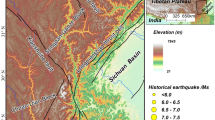Abstract
The Iwate–Miyagi Nairiku Earthquake in 2008, whose seismic intensity was M. 7.2 in Japan Meteorological Agency (JMA) scale, induced innumerable landslides on the southern flank of Mt. Kurikoma volcano allocated along the Ou Backbone Range in Northeast Japan. Most landslides are detected in a hanging wall side of the seismic fault. Those landslides are classified into five types: deep-seated slide, debris slide, shallow debris slide, secondary shallow debris slide, and debris flow. Most common landslide types induced by the earthquake are shallow debris slides and subsequent debris flows. They are intensively distributed along steep gorges incising a volcanic skirt of Mt. Kurikoma, consisting of welded ignimbrite of the Pleistocene age. Debris flows are also distributed even along gentle river floors in the southern lower flank of the volcano. The area of densely distributed debris slides, shallow debris slides, and debris flows is concordant with that of severe seismic tremor. Thus, genetic processes of landslides induced by the Iwate–Miyagi Nairiku Earthquake in 2008 are attributed to multiple causative factors such as geology, topography, and seismic force.











Similar content being viewed by others
References
Horikawa H (2008) Source process of the Iwate–Miyagi Nairiku Earthquake in 2008 inferred from strong motion wave forms. AFRC News 81(7):1–4
Japan Meteorological Agency (2008) Evaluation of the Iwate–Miyagi Nairiku Earthquake in 2008 (mainly on surface rupture). http://www.jishin.go.jp/main/chousa/08jul_iwate_miyagi/p07.htm
Joint Observation Group of Universities and Research Institute across the Country (2008) Feature: Iwate–Miyagi Nairiku Earthquake 2008. http://www.aob.geophys.tohoku.ac.jp/GIMNE2008/
National Research Institute for Earth Science and Disaster Prevention (2008) Peak acceleration contour map, http://www.kyoshin.bosai.go.jp/kyoshin/
Nunohara K, Yoshida T, Yoshida R (2008) Relationship between earthquake disasters and caldera structures using of GIS. Abstract, the 2009 National Conference, Geological Society of Japan, http://www.geosociety.jp/hazard/content0035.html
Ohba T, Yamamoto M, Kondo A, Suzuki S, Hayashi S (2009) Stratigraphy of the landslide disaster area by the Iwate Miyagi Inland Earthquake, In: The Joint Research Project of Three North Tohoku National Universities: Research report of the disaster survey of the Iwate Miyagi Inland Earthquake, Akita, pp. 24–35
Owen L, Kamp U, Khattak GA, Harp E, Keefer D, Bauer MA (2008) Landslides triggered by the 8 October 2005 Kashimir Earthquake. Geomorphology 94:1–9
Sato H (1994) The relationship between late Cenozoic tectonic events and stress field and basin development in northeast Japan. J Geophys Res 99:22261–22274
Toda S, Murayama T, Yoshimi M, Awata Y, Kaneda H, Yoshida T, Ando R (2008) The enigmatic 2008 Mw 6.9 Iwate–Miyagi Nairiku, Japan earthquake: A large shallow thrust event with little surface displacement and scant evidence for paleo-seismic slip, EOS Trans. AGU 9-53, Fall Meet Suppl Abstract T51C-04
Tohoku Construction Association (2006) Digital geological map of Tohoku District in the scale of 1/200,000.
Varnes DJ (1978) Slope movement types and processes. In: Schuster RL, Krizek RJ (eds) Landslides: Analysis and Control, Special report 176, TRB, National Research Council, Washington D.C. pp. 11–33
Yagi H (2007) Landslides and slope failures triggered by the 2005 Northern Pakistan Earthquake. In: Japan International Cooperation Agency and the Japan Landslide Society (2002) Transport plan study in the Islamic Republic of Pakistan, Progress Report II (Landslide Disaster Prevention), Tokyo, pp. 23–37
Yagi H, Yamasaki T, Atsumi M (2007) GIS analysis on geomorphological features and soil mechanical implication of landslides caused by the 2004 Niigata Chuetsu Earthquake. J Japan Landslide Society 43(5):294–306
Yoshida T (2001) The evolution of arc magmatism in the NE Honshu arc. Japan. Tohoku Geophys J 36(2):131–149
Acknowledgement
Authors deeply appreciate Prof. Sassa for his encouragement for the submission of this paper. Authors also thank the staff of Japan Conservation Engineers Co. Ltd. for their arrangement of much data and thank the Tohoku Forestry Agency for making the aerial photos available.
Author information
Authors and Affiliations
Corresponding author
Rights and permissions
About this article
Cite this article
Yagi, H., Sato, G., Higaki, D. et al. Distribution and characteristics of landslides induced by the Iwate–Miyagi Nairiku Earthquake in 2008 in Tohoku District, Northeast Japan. Landslides 6, 335–344 (2009). https://doi.org/10.1007/s10346-009-0182-3
Received:
Accepted:
Published:
Issue Date:
DOI: https://doi.org/10.1007/s10346-009-0182-3




